DJI RS 4 Pro Technical Review: A Quantum Leap in Solo Cinematography and Intelligent Stabilization
Introduction: The Evolution from Stabilizer to Cinematic Ecosystem
In the rapidly evolving world of digital filmmaking, the 3-axis gimbal has transitioned from a niche accessory to an indispensable tool for creators of all levels. However, the market has reached a point of maturity where incremental improvements in stabilization are no longer enough to define a new generation. A truly “pro” device must do more than simply smooth out footsteps; it must intelligently integrate into a workflow, automate complex tasks, and empower a single operator to achieve shots that once required an entire crew. It is with this profound understanding that DJI has unleashed the DJI RS 4 Pro. This is not just a gimbal stabilizer; it is the brain of a modular, expandable, and breathtakingly intelligent cinematic ecosystem designed for the ambitious solo cinematographer and the agile small-crew production.
The RS 4 Pro represents a paradigm shift, moving the focus from mere motion compensation to comprehensive camera and lens control. It is built upon a foundation of immense power—lightweight carbon fiber arms capable of handling professional cinema camera payloads, driven by motors with a 20% torque increase for unparalleled responsiveness. But its true genius lies in the layers of intelligent technology built upon that foundation. The introduction of a revolutionary next-generation LiDAR autofocus system promises to make pulling focus on manual cinema lenses a reliable, automated task. The complete redesign of the mounting system for 2nd-Gen Native Vertical Shooting addresses a critical need for modern content creators with mechanical simplicity and speed. And the expansion of the video transmission and remote control ecosystem transforms the gimbal from a handheld device into the command center of a cohesive on-set network.
This is a tool designed for professionals and prosumers who understand that efficiency is a creative advantage. It is for the documentarian who needs to track a subject with flawless focus, the commercial director who needs to execute a precise, repeatable zoom pull, and the social media content creator who needs to switch from a horizontal cinematic frame to a vertical story format in seconds. In this exhaustive technical review, we will perform a granular dissection of the engineering and software innovations that define the DJI RS 4 Pro. We will analyze the physics of its increased payload capacity, deconstruct the light-speed calculations of its LiDAR ranging system, and evaluate the real-world workflow implications of its integrated control systems. This is an in-depth analysis for the discerning creator who demands more than just stability—they demand a truly intelligent creative partner.

A Deep Dive into the Key Features: A Granular Analysis of Core Technologies
The DJI RS 4 Pro’s status as a professional-grade tool is not derived from a single specification but from the sophisticated interplay of advanced mechanical engineering, powerful processing, and a deeply integrated software ecosystem. We will now dissect each key feature from a technical perspective to understand its true impact on the filmmaking process.
-
Payload Capacity and Motor Performance: The Physics of Power and Precision
The foundational capability of any gimbal is its ability to carry a camera package and counteract external forces. The RS 4 Pro boasts a significant 4.5kg (10lbs) payload capacity, a figure that places it firmly in the professional category, capable of handling not just mainstream mirrorless cameras, but also compact cinema cameras like a RED Komodo or a Canon C70 with a cinema lens. However, the more critical technical specification is the 20% increase in motor torque across all three axes (pan, tilt, and roll) compared to its predecessor. This is a monumental engineering upgrade. Increased torque provides the motors with greater authority to resist sudden, high-frequency movements (like those experienced when running or shooting from a moving vehicle) and to manage unbalanced loads more effectively during extreme angle transitions. This results in a higher fidelity of stabilization, eliminating the micro-jitters and motor strain that can plague less powerful gimbals when pushed to their limits. It gives the operator the confidence to execute more aggressive and dynamic camera movements without fear of the gimbal failing to keep up.
This increase in power is achieved without a significant weight penalty thanks to the use of carbon fiber axis arms. Carbon fiber offers a superior strength-to-weight ratio compared to the aluminum used in many other gimbals. This allows the arms to be incredibly rigid—resisting flex and vibration that could be transmitted to the camera—while remaining lightweight. The result is a gimbal that is both immensely powerful and manageable for a single operator over extended shooting periods, a critical balance for real-world production scenarios.
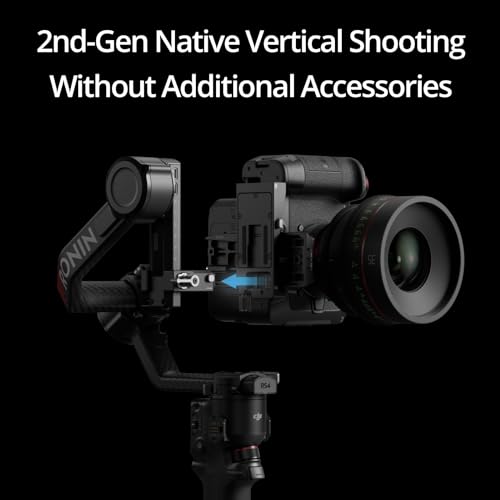
-
Workflow Revolution: 2nd-Gen Native Vertical Shooting
In the modern content landscape, the 9:16 vertical aspect ratio is as important as the traditional 16:9 cinematic frame. Previous gimbals treated vertical shooting as an afterthought, often requiring the purchase of a separate L-bracket, which added weight, complexity, and necessitated a complete re-balancing of the camera. The RS 4 Pro’s 2nd-Gen Native Vertical Shooting is a complete mechanical redesign that solves this problem with elegant simplicity. The new design allows the operator to simply release a lock on the horizontal arm, remove the entire quick-release plate assembly, and secure it directly into a vertical mount on the gimbal arm. This is an “effortless switch” that takes a matter of seconds, not minutes. The camera retains its center of gravity, meaning only a minimal forward/backward adjustment is typically needed to re-balance. This is a transformative workflow enhancement. It allows a creator on a fast-paced shoot to capture both a cinematic horizontal take for YouTube and a perfectly framed vertical take for Instagram Reels or TikTok, without any significant downtime. It respects vertical video as a first-class citizen, a critical feature for any modern hybrid shooter.
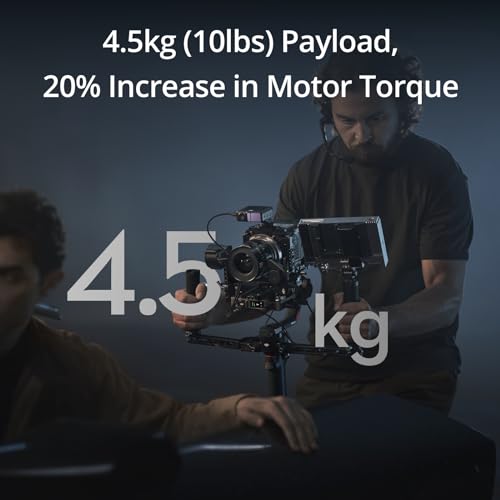
-
The Autofocus Game-Changer: Next-Generation LiDAR Focusing
This is arguably the RS 4 Pro’s most revolutionary feature. Traditionally, achieving cinematic, shallow-depth-of-field shots with manual cinema lenses required a dedicated focus puller. The Focus Pro LiDAR (Light Detection and Ranging) system automates this complex task with stunning accuracy. The LiDAR unit projects an invisible matrix of infrared laser beams into the scene. By measuring the time-of-flight for these beams to reflect off the subject and return, it creates a real-time, three-dimensional depth map of the environment. The new system boasts an incredible 76,800 ranging points—a massive increase over the previous generation—and an effective range of 20 meters (approx. 66 feet). This dense cloud of data allows the system to identify and track a subject with far greater precision and at greater distances.
This depth information is then fed to the new Focus Pro Motor, which physically drives the focus ring of a manual lens. The result is a highly responsive and reliable autofocus experience on lenses that were never designed for it. For a solo creator, this is a superpower. It allows you to track a walking subject, maintain critical focus on their eyes during an interview, or execute smooth focus racks from a foreground object to a background subject, all automatically. Unlike a camera’s native phase-detect or contrast-detect autofocus, LiDAR AF is not dependent on the scene’s lighting or contrast. It works just as effectively in near-complete darkness as it does in broad daylight, making it an incredibly robust and reliable tool for filmmakers in any environment.
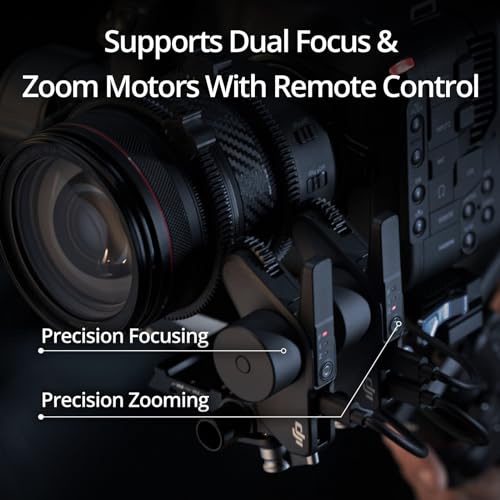
-
Enhanced Operator Control: Remote Dual Focus & Zoom Motor Integration
The RS 4 Pro enhances the operator’s direct control over the lens with a new, intuitive interface. The new joystick mode switch is a small but brilliant ergonomic improvement. It allows the cinematographer to toggle the function of the main joystick on the fly. In one mode, the joystick controls the gimbal’s pan and tilt movement, as expected. With a flick of the switch, the joystick is remapped to control the Focus Pro Motor. This provides “precise joystick control” for executing manual, variable-speed focus or zoom pulls with a single thumb. This is an incredibly powerful feature for adding production value, allowing a solo operator to perform a slow, dramatic zoom-in or a subtle focus shift during a complex camera move. When paired with a second motor, the system can be configured for dual focus and zoom control, often managed via the front dial for one function and the joystick for the other, giving the operator an unprecedented level of direct, tactile control over the lens.
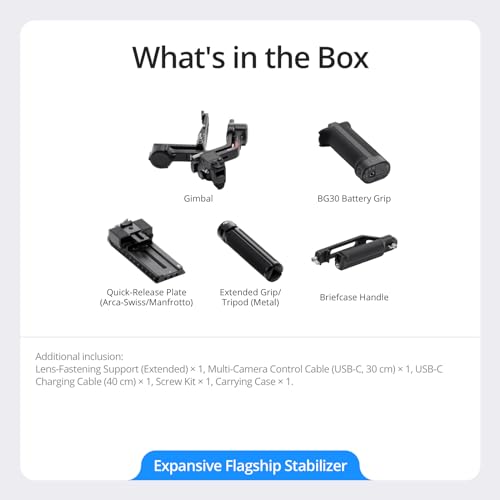
-
The Power of the Ecosystem: Video Transmission and Collaborative Control
The “Pro” in RS 4 Pro is most evident in its deep integration with DJI’s Video Transmission Ecosystem. This is what elevates it from a standalone stabilizer to the central hub of a production. When paired with the optional DJI Ronin Image Transmitter, the gimbal can broadcast a low-latency, high-definition video feed to remote monitors or smartphones running the Ronin app. This allows a director, client, or a separate camera operator to see what the gimbal operator is shooting in real time. But it goes far beyond simple monitoring. This ecosystem allows for a suite of “intelligent focus assistance” tools, such as remote waveform and vectorscope monitoring. Most powerfully, it enables collaborative control. A second operator using a device like the DJI Master Wheels or even just their smartphone can remotely control the gimbal’s movement, while the primary operator focuses on navigating the physical space. The LiDAR system can even output its depth map as a “LiDAR Waveform,” a visual guide that allows a remote focus puller to see their subject’s distance and nail focus manually from afar. This “extensive control ecosystem” broadens production possibilities, enabling small crews to achieve a level of coordination and precision previously reserved for large-budget productions.
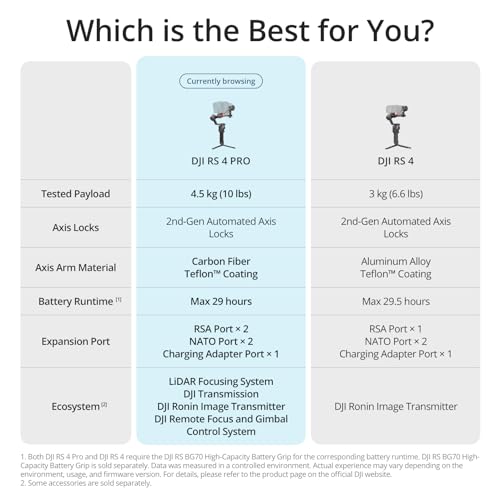
-
Marathon Endurance: The High-Capacity Battery System
For event videographers, documentarians, and anyone on a long production day, battery life is a constant source of anxiety. The standard included BG30 Battery Grip offers excellent runtime. However, the ecosystem supports the optional DJI RS BG70 High-Capacity Battery Grip, which extends the operational runtime up to a staggering 29 hours. This is more than enough to cover multiple days of shooting without a recharge. Just as importantly, the BG70 grip is not just a power source for the gimbal. Its USB-C port is capable of outputting up to 18W of power. This allows the grip to “power your camera and accessories,” such as a focus motor or a small on-camera monitor, directly. This simplifies rigging, reduces the number of individual batteries you need to manage, and streamlines your on-set power workflow, a crucial consideration for any professional.
Pros: The Undeniable Technical Strengths of the RS 4 Pro
- Flagship-Level Motor Performance: The 4.5kg payload and 20% torque increase, combined with carbon fiber arms, provide the power to handle professional cinema rigs with exceptional stability.
- Game-Changing LiDAR Autofocus: The next-generation LiDAR system with 76,800 ranging points offers incredibly accurate and reliable autofocus on manual lenses, empowering solo creators.
- Brilliant and Efficient Workflow: The 2nd-Gen Native Vertical Shooting mechanism is a massive time-saver and a mechanically superior solution for creating social content.
- Deep Ecosystem Integration: Seamlessly works with the Ronin Image Transmitter and Focus Pro motors to create a cohesive and powerful remote control and monitoring system.
- Intuitive Operator Control: The new joystick mode switch for toggling between gimbal and lens control is a smart, ergonomic enhancement for solo shooters.
- Exceptional Endurance: The option for a 29-hour high-capacity battery grip that can also power accessories simplifies power management on long shoots.
- Automated Axis Locks and Teflon Coating: Small but significant quality-of-life improvements that make balancing faster, smoother, and more efficient.

Cons: Important Technical Considerations and Limitations
- Ecosystem Can Be Costly: While the base gimbal is reasonably priced, unlocking its full potential (LiDAR AF, video transmission) requires purchasing the “Combo” kit or expensive add-on accessories.
- Increased Complexity: The sheer number of features and the depth of the ecosystem can present a steep learning curve for those new to professional gimbals. This is a pro tool, not a beginner’s device.
- Weight When Fully Rigged: While the gimbal itself is light for its class, once you add a cinema camera, lens, LiDAR, focus motor, and transmitter, the total weight can become substantial for long handheld takes.
- Reliance on DJI’s Proprietary Ecosystem: The system is designed to work best with DJI’s own accessories (Focus Pro motors, Ronin transmitter). Integrating third-party components can be more challenging.
- App Dependence: Like all DJI products, initial activation, firmware updates, and access to certain advanced settings require the use of the DJI Ronin smartphone app.
Conclusion: The New Standard for the Empowered Solo Filmmaker
The DJI RS 4 Pro is far more than an iterative update; it is a powerful statement about the future of independent filmmaking. It successfully transcends the category of a simple “stabilizer” to become the intelligent core of a comprehensive production ecosystem. By focusing on solving the most significant challenges faced by solo operators and small crews—namely, achieving precise focus, executing complex lens moves, and creating efficient workflows between horizontal and vertical formats—DJI has crafted a tool that actively empowers creativity. The performance of its motors is top-tier, but it’s the revolutionary LiDAR autofocus system that truly sets it apart, offering a level of automated precision that was previously the stuff of science fiction for manual lens users.
While the investment required to unlock its full ecosystem potential is significant, the capabilities it provides are transformative. It allows a single operator to achieve shots with a level of polish, precision, and production value that would have required a multi-person crew just a few years ago. It is a complex, professional tool that rewards the user who is willing to master its depths. For the dedicated content creator, the independent filmmaker, the event videographer, and the ambitious prosumer, the DJI RS 4 Pro is not just the best gimbal in its class; it is the most intelligent, forward-thinking, and creatively liberating cinematic tool on the market today. It has unequivocally earned its “Pro” moniker and our highest technical recommendation.
Frequently Asked Questions (FAQs)
- Q1: What is the main technical difference between the DJI RS 4 Pro and the standard RS 4?
- A: The main differences are payload capacity and materials. The RS 4 Pro is built with carbon fiber arms, has a 4.5kg (10lbs) payload, and a 20% motor torque increase, making it suitable for heavier cinema cameras. The standard RS 4 has aluminum arms and a 3kg (6.6lbs) payload, designed for mainstream mirrorless cameras. The Pro also has deeper integration with the LiDAR and video transmission ecosystem.
- Q2: How does the LiDAR autofocus compare to my camera’s built-in autofocus?
- A: They work very differently. Your camera’s AF uses the image sensor (contrast or phase detection) and only works with autofocus lenses. The LiDAR system is completely independent. It uses lasers to measure distance and can provide autofocus for ANY lens, including fully manual cinema lenses that have no electronics. LiDAR is also generally more reliable in low light and low-contrast situations where camera AF can struggle.
- Q3: Do I have to use the DJI Ronin app from the website? Why isn’t it on Google Play?
- A: Yes, due to compatibility and policy issues, the app is not currently available on the Google Play Store. Android users must download the APK file directly from the official DJI website and “sideload” it onto their device. This is a secure and standard practice for DJI apps on Android. The app is required for initial activation, firmware updates, and accessing the full feature set.
- Q4: Can I use older Ronin accessories, like the Focus Motor from the RS 2, with the RS 4 Pro?
- A: The RS 4 Pro is designed to work with the new “Focus Pro” motor system. While some older accessories may have limited cross-compatibility, for full functionality, especially with the LiDAR system and the new joystick controls, using the new Focus Pro motor is required. The new motor is faster, more powerful, and has lower latency to keep up with the LiDAR data.
- Q5: What is the benefit of the Teflon coating on the axis arms?
- A: The Teflon coating on all three axes is a significant quality-of-life improvement. It creates a lower-friction surface, which makes the process of balancing the camera much smoother. When you unlock an axis to make a small adjustment, the camera slides more easily and with less “stiction,” allowing you to achieve a perfect balance with greater precision and speed.
- Q6: What is the difference between the “Standard Combo” and the full “Combo” kit?
- A: The “Standard Combo” (or just the base gimbal) typically includes the gimbal, battery grip, and essential mounting plates. The full “Combo” kit is a much more comprehensive package that adds crucial ecosystem components, including the new Focus Pro Motor, the Ronin Image Transmitter (RavenEye), and all the necessary cables and mounting rods. For anyone wanting to use the LiDAR AF or remote monitoring, the Combo kit is the much more cost-effective option.
See more posts in the category Cameras.







